Management Unit: An Analysis of Pixar's Operational Strategies
VerifiedAdded on 2023/06/05
|9
|2878
|124
Report
AI Summary
This report provides a detailed analysis of Pixar's management unit, examining its historical journey, key success factors, and the challenges it faced, particularly in its relationship with Disney. The report highlights the innovative management structure that contributed to Pixar's acclaimed success, emphasizing the cultural and free-spirited work environment. It delves into the issues of trust between Pixar and Disney, and how Bob Iger addressed these challenges, including the importance of employee opinions. The report explores the company's strengths, such as its human capital and technical expertise, and weaknesses, including the lack of film distribution experience. The report also discusses the external threats, such as increasing competition and the evolving animation industry. It presents recommendations for Pixar's future, including standing alone, alliances with distribution companies, renegotiating agreements with Disney, selling to Disney, and venturing into TV production.
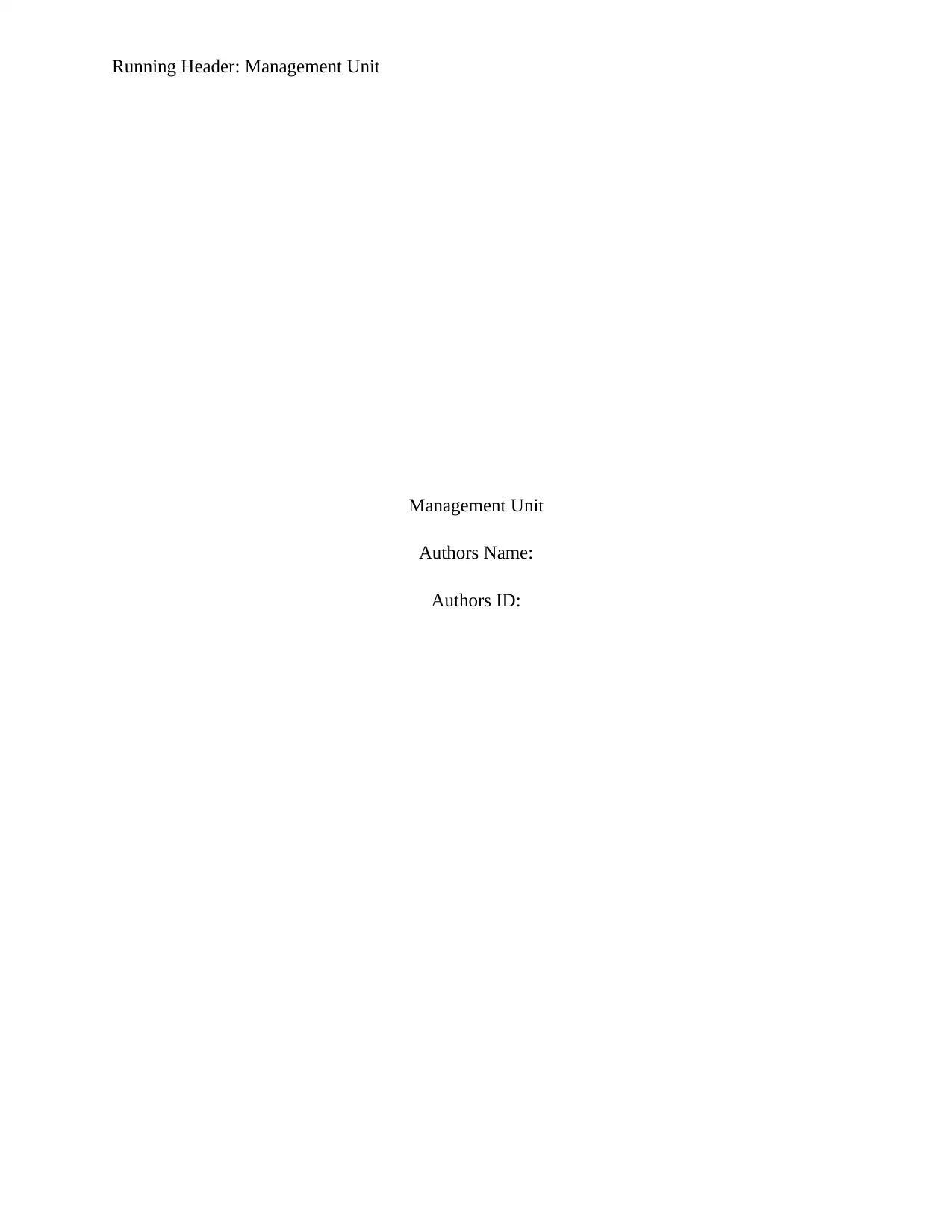
Running Header: Management Unit
Management Unit
Authors Name:
Authors ID:
Management Unit
Authors Name:
Authors ID:
Paraphrase This Document
Need a fresh take? Get an instant paraphrase of this document with our AI Paraphraser
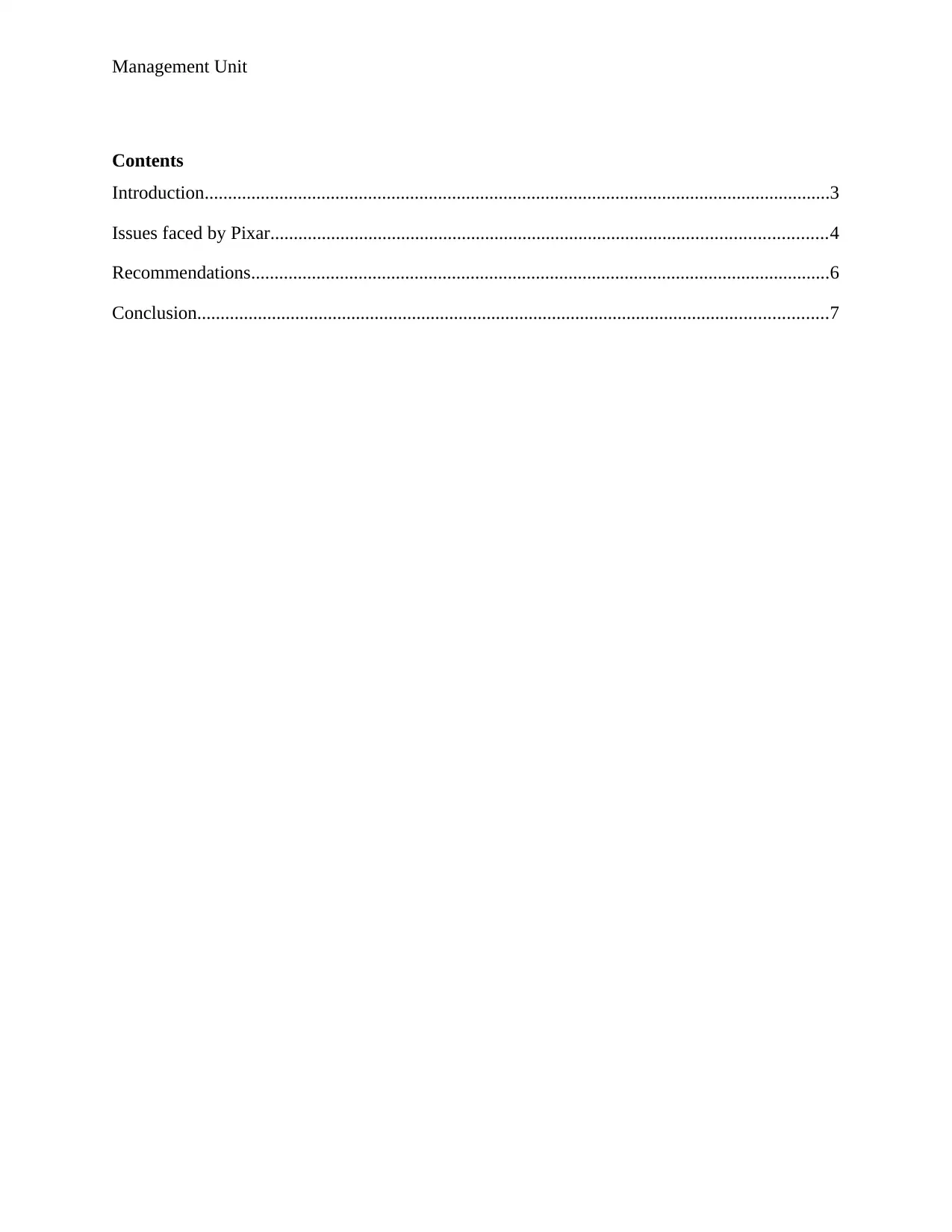
Management Unit
Contents
Introduction......................................................................................................................................3
Issues faced by Pixar.......................................................................................................................4
Recommendations............................................................................................................................6
Conclusion.......................................................................................................................................7
Contents
Introduction......................................................................................................................................3
Issues faced by Pixar.......................................................................................................................4
Recommendations............................................................................................................................6
Conclusion.......................................................................................................................................7
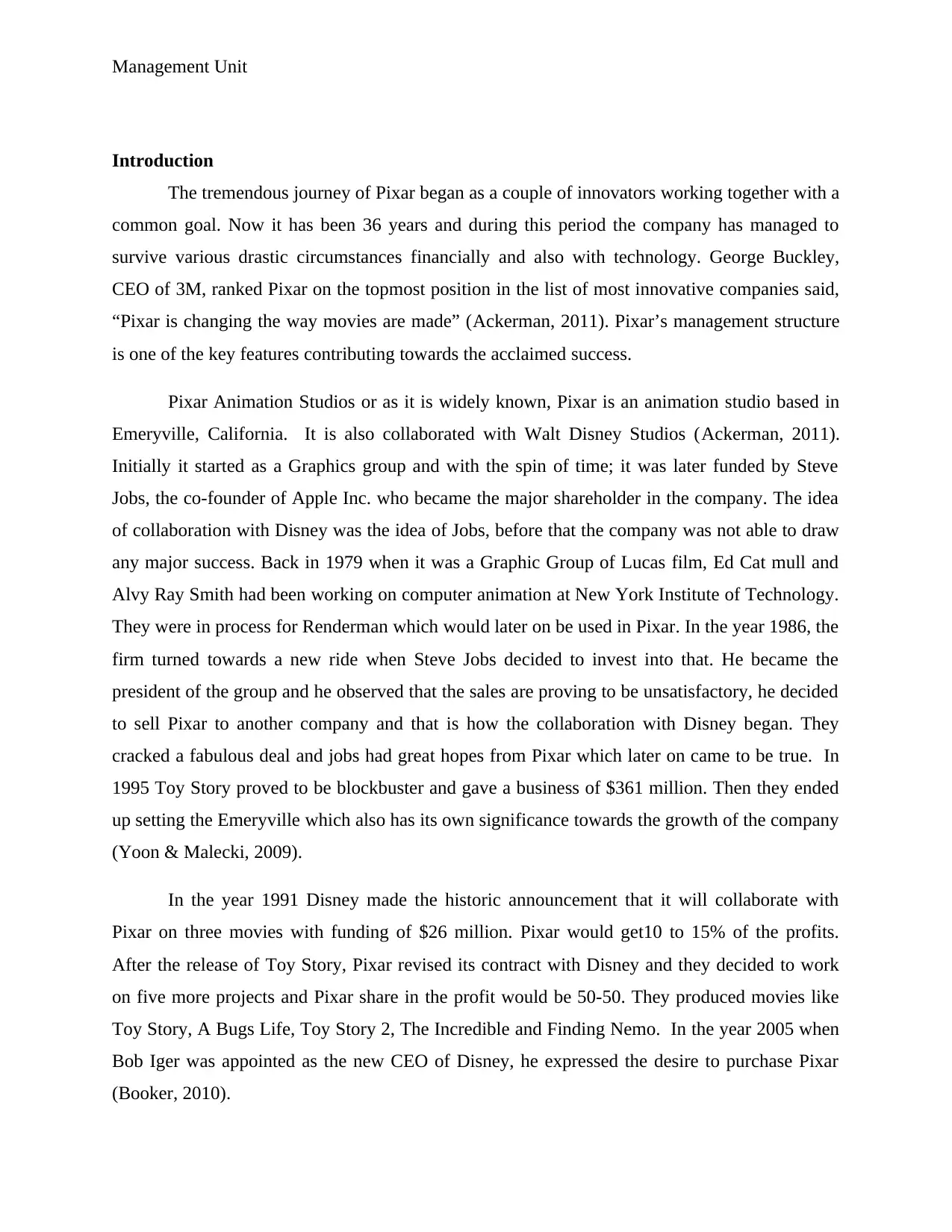
Management Unit
Introduction
The tremendous journey of Pixar began as a couple of innovators working together with a
common goal. Now it has been 36 years and during this period the company has managed to
survive various drastic circumstances financially and also with technology. George Buckley,
CEO of 3M, ranked Pixar on the topmost position in the list of most innovative companies said,
“Pixar is changing the way movies are made” (Ackerman, 2011). Pixar’s management structure
is one of the key features contributing towards the acclaimed success.
Pixar Animation Studios or as it is widely known, Pixar is an animation studio based in
Emeryville, California. It is also collaborated with Walt Disney Studios (Ackerman, 2011).
Initially it started as a Graphics group and with the spin of time; it was later funded by Steve
Jobs, the co-founder of Apple Inc. who became the major shareholder in the company. The idea
of collaboration with Disney was the idea of Jobs, before that the company was not able to draw
any major success. Back in 1979 when it was a Graphic Group of Lucas film, Ed Cat mull and
Alvy Ray Smith had been working on computer animation at New York Institute of Technology.
They were in process for Renderman which would later on be used in Pixar. In the year 1986, the
firm turned towards a new ride when Steve Jobs decided to invest into that. He became the
president of the group and he observed that the sales are proving to be unsatisfactory, he decided
to sell Pixar to another company and that is how the collaboration with Disney began. They
cracked a fabulous deal and jobs had great hopes from Pixar which later on came to be true. In
1995 Toy Story proved to be blockbuster and gave a business of $361 million. Then they ended
up setting the Emeryville which also has its own significance towards the growth of the company
(Yoon & Malecki, 2009).
In the year 1991 Disney made the historic announcement that it will collaborate with
Pixar on three movies with funding of $26 million. Pixar would get10 to 15% of the profits.
After the release of Toy Story, Pixar revised its contract with Disney and they decided to work
on five more projects and Pixar share in the profit would be 50-50. They produced movies like
Toy Story, A Bugs Life, Toy Story 2, The Incredible and Finding Nemo. In the year 2005 when
Bob Iger was appointed as the new CEO of Disney, he expressed the desire to purchase Pixar
(Booker, 2010).
Introduction
The tremendous journey of Pixar began as a couple of innovators working together with a
common goal. Now it has been 36 years and during this period the company has managed to
survive various drastic circumstances financially and also with technology. George Buckley,
CEO of 3M, ranked Pixar on the topmost position in the list of most innovative companies said,
“Pixar is changing the way movies are made” (Ackerman, 2011). Pixar’s management structure
is one of the key features contributing towards the acclaimed success.
Pixar Animation Studios or as it is widely known, Pixar is an animation studio based in
Emeryville, California. It is also collaborated with Walt Disney Studios (Ackerman, 2011).
Initially it started as a Graphics group and with the spin of time; it was later funded by Steve
Jobs, the co-founder of Apple Inc. who became the major shareholder in the company. The idea
of collaboration with Disney was the idea of Jobs, before that the company was not able to draw
any major success. Back in 1979 when it was a Graphic Group of Lucas film, Ed Cat mull and
Alvy Ray Smith had been working on computer animation at New York Institute of Technology.
They were in process for Renderman which would later on be used in Pixar. In the year 1986, the
firm turned towards a new ride when Steve Jobs decided to invest into that. He became the
president of the group and he observed that the sales are proving to be unsatisfactory, he decided
to sell Pixar to another company and that is how the collaboration with Disney began. They
cracked a fabulous deal and jobs had great hopes from Pixar which later on came to be true. In
1995 Toy Story proved to be blockbuster and gave a business of $361 million. Then they ended
up setting the Emeryville which also has its own significance towards the growth of the company
(Yoon & Malecki, 2009).
In the year 1991 Disney made the historic announcement that it will collaborate with
Pixar on three movies with funding of $26 million. Pixar would get10 to 15% of the profits.
After the release of Toy Story, Pixar revised its contract with Disney and they decided to work
on five more projects and Pixar share in the profit would be 50-50. They produced movies like
Toy Story, A Bugs Life, Toy Story 2, The Incredible and Finding Nemo. In the year 2005 when
Bob Iger was appointed as the new CEO of Disney, he expressed the desire to purchase Pixar
(Booker, 2010).
⊘ This is a preview!⊘
Do you want full access?
Subscribe today to unlock all pages.

Trusted by 1+ million students worldwide
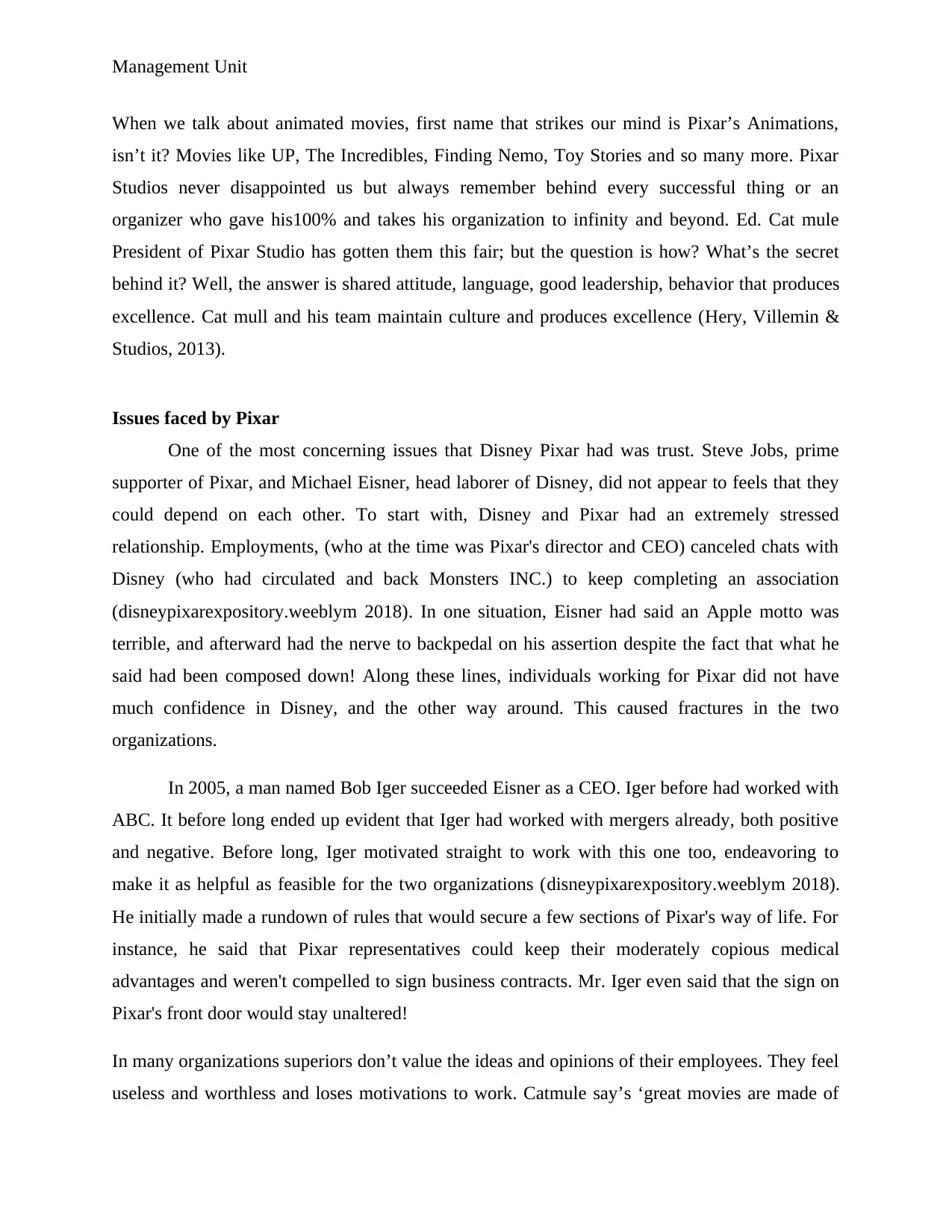
Management Unit
When we talk about animated movies, first name that strikes our mind is Pixar’s Animations,
isn’t it? Movies like UP, The Incredibles, Finding Nemo, Toy Stories and so many more. Pixar
Studios never disappointed us but always remember behind every successful thing or an
organizer who gave his100% and takes his organization to infinity and beyond. Ed. Cat mule
President of Pixar Studio has gotten them this fair; but the question is how? What’s the secret
behind it? Well, the answer is shared attitude, language, good leadership, behavior that produces
excellence. Cat mull and his team maintain culture and produces excellence (Hery, Villemin &
Studios, 2013).
Issues faced by Pixar
One of the most concerning issues that Disney Pixar had was trust. Steve Jobs, prime
supporter of Pixar, and Michael Eisner, head laborer of Disney, did not appear to feels that they
could depend on each other. To start with, Disney and Pixar had an extremely stressed
relationship. Employments, (who at the time was Pixar's director and CEO) canceled chats with
Disney (who had circulated and back Monsters INC.) to keep completing an association
(disneypixarexpository.weeblym 2018). In one situation, Eisner had said an Apple motto was
terrible, and afterward had the nerve to backpedal on his assertion despite the fact that what he
said had been composed down! Along these lines, individuals working for Pixar did not have
much confidence in Disney, and the other way around. This caused fractures in the two
organizations.
In 2005, a man named Bob Iger succeeded Eisner as a CEO. Iger before had worked with
ABC. It before long ended up evident that Iger had worked with mergers already, both positive
and negative. Before long, Iger motivated straight to work with this one too, endeavoring to
make it as helpful as feasible for the two organizations (disneypixarexpository.weeblym 2018).
He initially made a rundown of rules that would secure a few sections of Pixar's way of life. For
instance, he said that Pixar representatives could keep their moderately copious medical
advantages and weren't compelled to sign business contracts. Mr. Iger even said that the sign on
Pixar's front door would stay unaltered!
In many organizations superiors don’t value the ideas and opinions of their employees. They feel
useless and worthless and loses motivations to work. Catmule say’s ‘great movies are made of
When we talk about animated movies, first name that strikes our mind is Pixar’s Animations,
isn’t it? Movies like UP, The Incredibles, Finding Nemo, Toy Stories and so many more. Pixar
Studios never disappointed us but always remember behind every successful thing or an
organizer who gave his100% and takes his organization to infinity and beyond. Ed. Cat mule
President of Pixar Studio has gotten them this fair; but the question is how? What’s the secret
behind it? Well, the answer is shared attitude, language, good leadership, behavior that produces
excellence. Cat mull and his team maintain culture and produces excellence (Hery, Villemin &
Studios, 2013).
Issues faced by Pixar
One of the most concerning issues that Disney Pixar had was trust. Steve Jobs, prime
supporter of Pixar, and Michael Eisner, head laborer of Disney, did not appear to feels that they
could depend on each other. To start with, Disney and Pixar had an extremely stressed
relationship. Employments, (who at the time was Pixar's director and CEO) canceled chats with
Disney (who had circulated and back Monsters INC.) to keep completing an association
(disneypixarexpository.weeblym 2018). In one situation, Eisner had said an Apple motto was
terrible, and afterward had the nerve to backpedal on his assertion despite the fact that what he
said had been composed down! Along these lines, individuals working for Pixar did not have
much confidence in Disney, and the other way around. This caused fractures in the two
organizations.
In 2005, a man named Bob Iger succeeded Eisner as a CEO. Iger before had worked with
ABC. It before long ended up evident that Iger had worked with mergers already, both positive
and negative. Before long, Iger motivated straight to work with this one too, endeavoring to
make it as helpful as feasible for the two organizations (disneypixarexpository.weeblym 2018).
He initially made a rundown of rules that would secure a few sections of Pixar's way of life. For
instance, he said that Pixar representatives could keep their moderately copious medical
advantages and weren't compelled to sign business contracts. Mr. Iger even said that the sign on
Pixar's front door would stay unaltered!
In many organizations superiors don’t value the ideas and opinions of their employees. They feel
useless and worthless and loses motivations to work. Catmule say’s ‘great movies are made of
Paraphrase This Document
Need a fresh take? Get an instant paraphrase of this document with our AI Paraphraser
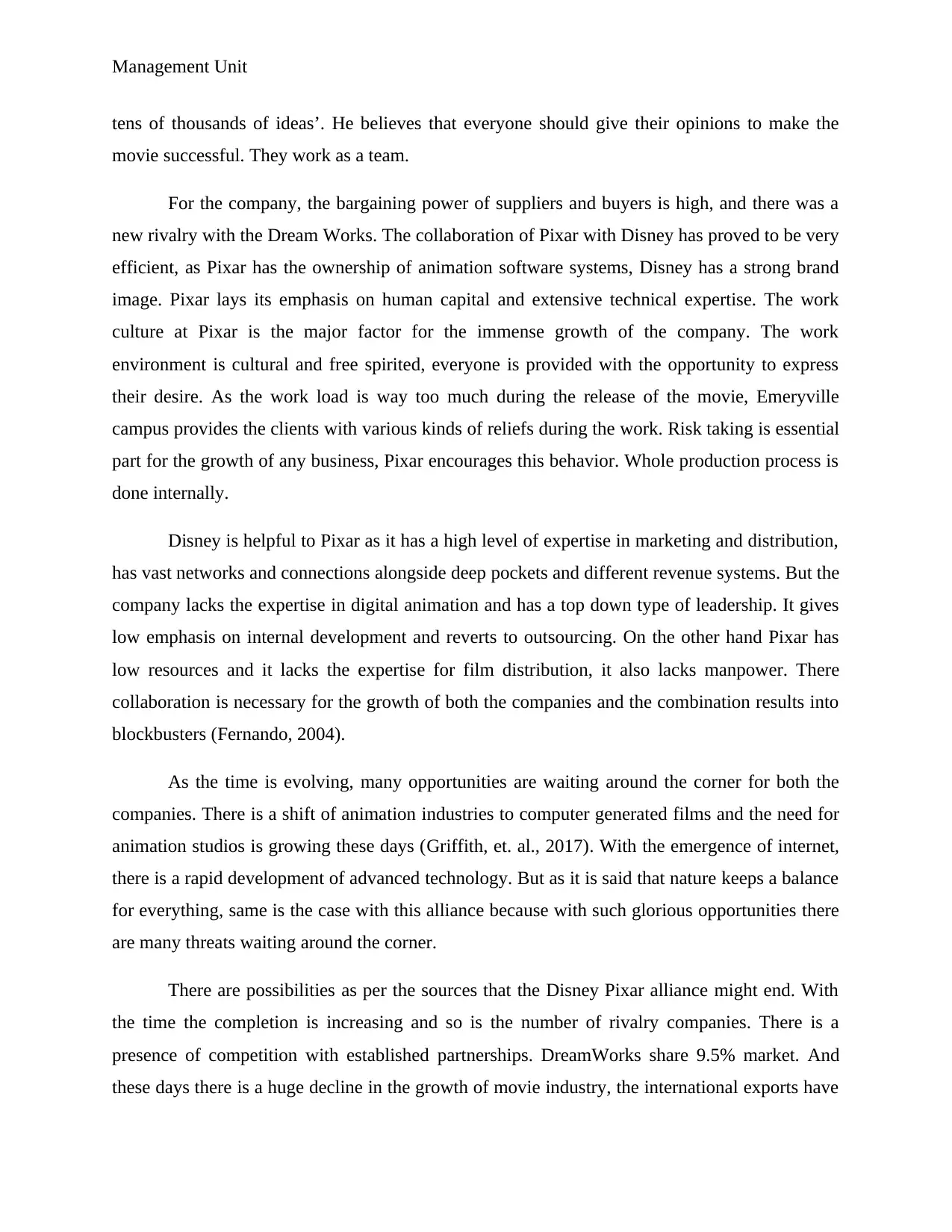
Management Unit
tens of thousands of ideas’. He believes that everyone should give their opinions to make the
movie successful. They work as a team.
For the company, the bargaining power of suppliers and buyers is high, and there was a
new rivalry with the Dream Works. The collaboration of Pixar with Disney has proved to be very
efficient, as Pixar has the ownership of animation software systems, Disney has a strong brand
image. Pixar lays its emphasis on human capital and extensive technical expertise. The work
culture at Pixar is the major factor for the immense growth of the company. The work
environment is cultural and free spirited, everyone is provided with the opportunity to express
their desire. As the work load is way too much during the release of the movie, Emeryville
campus provides the clients with various kinds of reliefs during the work. Risk taking is essential
part for the growth of any business, Pixar encourages this behavior. Whole production process is
done internally.
Disney is helpful to Pixar as it has a high level of expertise in marketing and distribution,
has vast networks and connections alongside deep pockets and different revenue systems. But the
company lacks the expertise in digital animation and has a top down type of leadership. It gives
low emphasis on internal development and reverts to outsourcing. On the other hand Pixar has
low resources and it lacks the expertise for film distribution, it also lacks manpower. There
collaboration is necessary for the growth of both the companies and the combination results into
blockbusters (Fernando, 2004).
As the time is evolving, many opportunities are waiting around the corner for both the
companies. There is a shift of animation industries to computer generated films and the need for
animation studios is growing these days (Griffith, et. al., 2017). With the emergence of internet,
there is a rapid development of advanced technology. But as it is said that nature keeps a balance
for everything, same is the case with this alliance because with such glorious opportunities there
are many threats waiting around the corner.
There are possibilities as per the sources that the Disney Pixar alliance might end. With
the time the completion is increasing and so is the number of rivalry companies. There is a
presence of competition with established partnerships. DreamWorks share 9.5% market. And
these days there is a huge decline in the growth of movie industry, the international exports have
tens of thousands of ideas’. He believes that everyone should give their opinions to make the
movie successful. They work as a team.
For the company, the bargaining power of suppliers and buyers is high, and there was a
new rivalry with the Dream Works. The collaboration of Pixar with Disney has proved to be very
efficient, as Pixar has the ownership of animation software systems, Disney has a strong brand
image. Pixar lays its emphasis on human capital and extensive technical expertise. The work
culture at Pixar is the major factor for the immense growth of the company. The work
environment is cultural and free spirited, everyone is provided with the opportunity to express
their desire. As the work load is way too much during the release of the movie, Emeryville
campus provides the clients with various kinds of reliefs during the work. Risk taking is essential
part for the growth of any business, Pixar encourages this behavior. Whole production process is
done internally.
Disney is helpful to Pixar as it has a high level of expertise in marketing and distribution,
has vast networks and connections alongside deep pockets and different revenue systems. But the
company lacks the expertise in digital animation and has a top down type of leadership. It gives
low emphasis on internal development and reverts to outsourcing. On the other hand Pixar has
low resources and it lacks the expertise for film distribution, it also lacks manpower. There
collaboration is necessary for the growth of both the companies and the combination results into
blockbusters (Fernando, 2004).
As the time is evolving, many opportunities are waiting around the corner for both the
companies. There is a shift of animation industries to computer generated films and the need for
animation studios is growing these days (Griffith, et. al., 2017). With the emergence of internet,
there is a rapid development of advanced technology. But as it is said that nature keeps a balance
for everything, same is the case with this alliance because with such glorious opportunities there
are many threats waiting around the corner.
There are possibilities as per the sources that the Disney Pixar alliance might end. With
the time the completion is increasing and so is the number of rivalry companies. There is a
presence of competition with established partnerships. DreamWorks share 9.5% market. And
these days there is a huge decline in the growth of movie industry, the international exports have
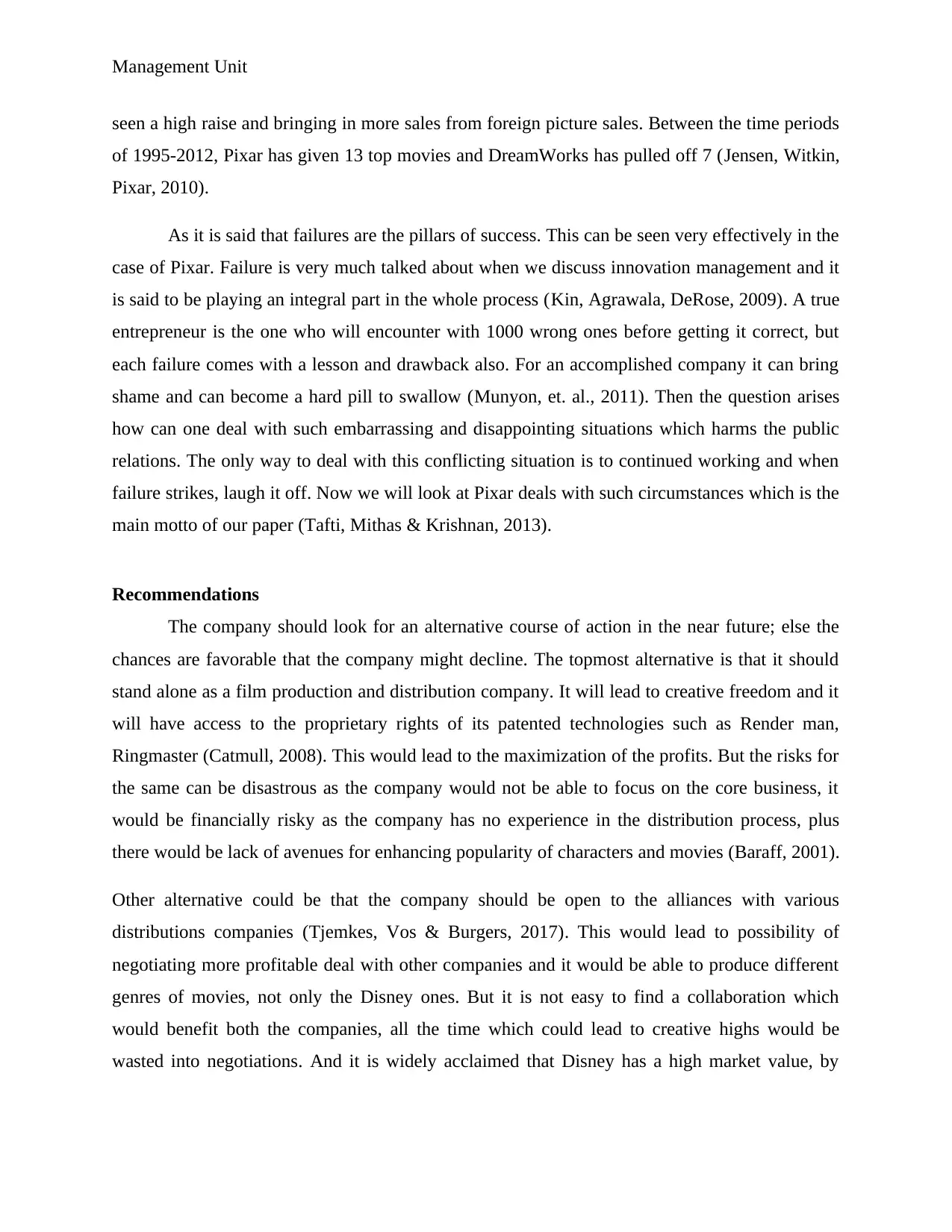
Management Unit
seen a high raise and bringing in more sales from foreign picture sales. Between the time periods
of 1995-2012, Pixar has given 13 top movies and DreamWorks has pulled off 7 (Jensen, Witkin,
Pixar, 2010).
As it is said that failures are the pillars of success. This can be seen very effectively in the
case of Pixar. Failure is very much talked about when we discuss innovation management and it
is said to be playing an integral part in the whole process (Kin, Agrawala, DeRose, 2009). A true
entrepreneur is the one who will encounter with 1000 wrong ones before getting it correct, but
each failure comes with a lesson and drawback also. For an accomplished company it can bring
shame and can become a hard pill to swallow (Munyon, et. al., 2011). Then the question arises
how can one deal with such embarrassing and disappointing situations which harms the public
relations. The only way to deal with this conflicting situation is to continued working and when
failure strikes, laugh it off. Now we will look at Pixar deals with such circumstances which is the
main motto of our paper (Tafti, Mithas & Krishnan, 2013).
Recommendations
The company should look for an alternative course of action in the near future; else the
chances are favorable that the company might decline. The topmost alternative is that it should
stand alone as a film production and distribution company. It will lead to creative freedom and it
will have access to the proprietary rights of its patented technologies such as Render man,
Ringmaster (Catmull, 2008). This would lead to the maximization of the profits. But the risks for
the same can be disastrous as the company would not be able to focus on the core business, it
would be financially risky as the company has no experience in the distribution process, plus
there would be lack of avenues for enhancing popularity of characters and movies (Baraff, 2001).
Other alternative could be that the company should be open to the alliances with various
distributions companies (Tjemkes, Vos & Burgers, 2017). This would lead to possibility of
negotiating more profitable deal with other companies and it would be able to produce different
genres of movies, not only the Disney ones. But it is not easy to find a collaboration which
would benefit both the companies, all the time which could lead to creative highs would be
wasted into negotiations. And it is widely acclaimed that Disney has a high market value, by
seen a high raise and bringing in more sales from foreign picture sales. Between the time periods
of 1995-2012, Pixar has given 13 top movies and DreamWorks has pulled off 7 (Jensen, Witkin,
Pixar, 2010).
As it is said that failures are the pillars of success. This can be seen very effectively in the
case of Pixar. Failure is very much talked about when we discuss innovation management and it
is said to be playing an integral part in the whole process (Kin, Agrawala, DeRose, 2009). A true
entrepreneur is the one who will encounter with 1000 wrong ones before getting it correct, but
each failure comes with a lesson and drawback also. For an accomplished company it can bring
shame and can become a hard pill to swallow (Munyon, et. al., 2011). Then the question arises
how can one deal with such embarrassing and disappointing situations which harms the public
relations. The only way to deal with this conflicting situation is to continued working and when
failure strikes, laugh it off. Now we will look at Pixar deals with such circumstances which is the
main motto of our paper (Tafti, Mithas & Krishnan, 2013).
Recommendations
The company should look for an alternative course of action in the near future; else the
chances are favorable that the company might decline. The topmost alternative is that it should
stand alone as a film production and distribution company. It will lead to creative freedom and it
will have access to the proprietary rights of its patented technologies such as Render man,
Ringmaster (Catmull, 2008). This would lead to the maximization of the profits. But the risks for
the same can be disastrous as the company would not be able to focus on the core business, it
would be financially risky as the company has no experience in the distribution process, plus
there would be lack of avenues for enhancing popularity of characters and movies (Baraff, 2001).
Other alternative could be that the company should be open to the alliances with various
distributions companies (Tjemkes, Vos & Burgers, 2017). This would lead to possibility of
negotiating more profitable deal with other companies and it would be able to produce different
genres of movies, not only the Disney ones. But it is not easy to find a collaboration which
would benefit both the companies, all the time which could lead to creative highs would be
wasted into negotiations. And it is widely acclaimed that Disney has a high market value, by
⊘ This is a preview!⊘
Do you want full access?
Subscribe today to unlock all pages.

Trusted by 1+ million students worldwide
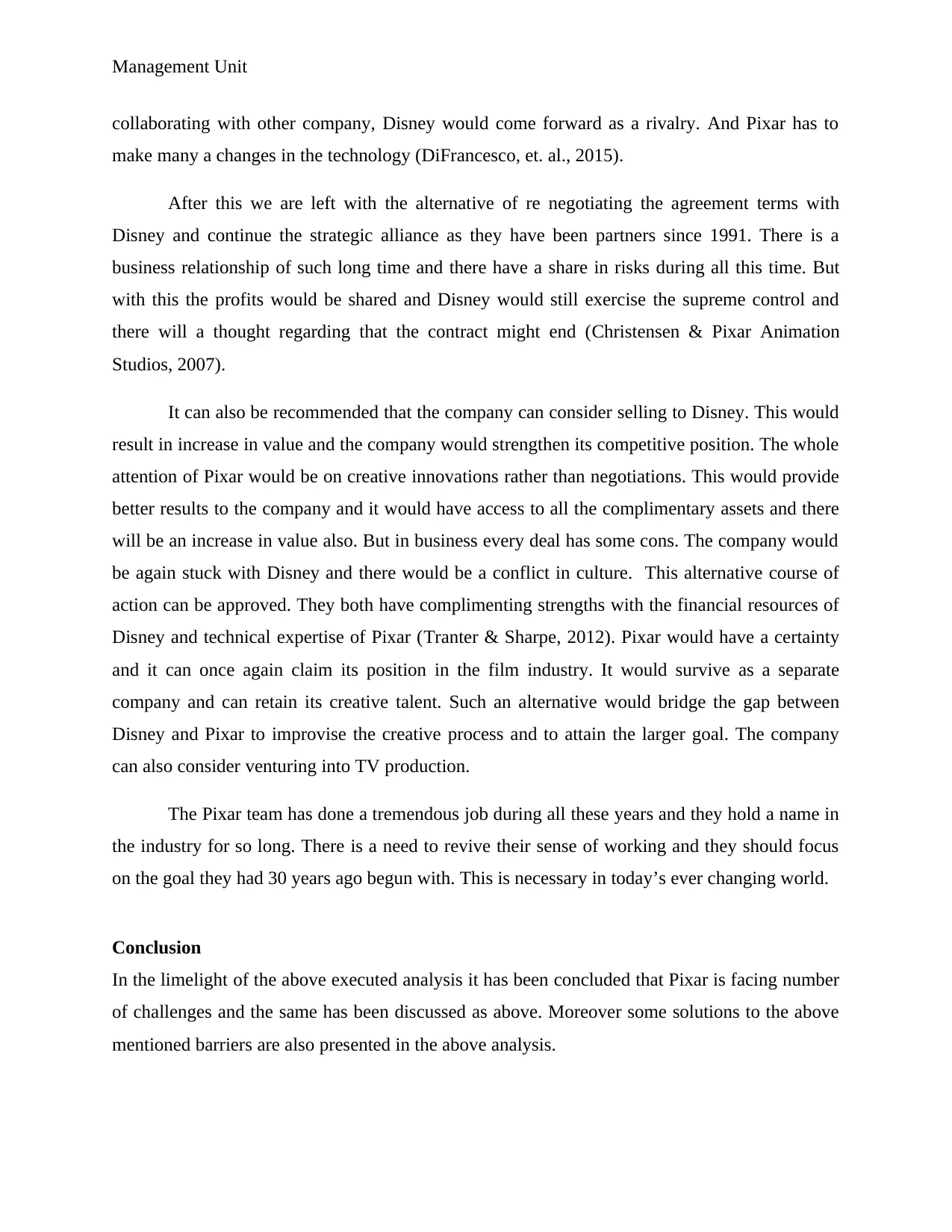
Management Unit
collaborating with other company, Disney would come forward as a rivalry. And Pixar has to
make many a changes in the technology (DiFrancesco, et. al., 2015).
After this we are left with the alternative of re negotiating the agreement terms with
Disney and continue the strategic alliance as they have been partners since 1991. There is a
business relationship of such long time and there have a share in risks during all this time. But
with this the profits would be shared and Disney would still exercise the supreme control and
there will a thought regarding that the contract might end (Christensen & Pixar Animation
Studios, 2007).
It can also be recommended that the company can consider selling to Disney. This would
result in increase in value and the company would strengthen its competitive position. The whole
attention of Pixar would be on creative innovations rather than negotiations. This would provide
better results to the company and it would have access to all the complimentary assets and there
will be an increase in value also. But in business every deal has some cons. The company would
be again stuck with Disney and there would be a conflict in culture. This alternative course of
action can be approved. They both have complimenting strengths with the financial resources of
Disney and technical expertise of Pixar (Tranter & Sharpe, 2012). Pixar would have a certainty
and it can once again claim its position in the film industry. It would survive as a separate
company and can retain its creative talent. Such an alternative would bridge the gap between
Disney and Pixar to improvise the creative process and to attain the larger goal. The company
can also consider venturing into TV production.
The Pixar team has done a tremendous job during all these years and they hold a name in
the industry for so long. There is a need to revive their sense of working and they should focus
on the goal they had 30 years ago begun with. This is necessary in today’s ever changing world.
Conclusion
In the limelight of the above executed analysis it has been concluded that Pixar is facing number
of challenges and the same has been discussed as above. Moreover some solutions to the above
mentioned barriers are also presented in the above analysis.
collaborating with other company, Disney would come forward as a rivalry. And Pixar has to
make many a changes in the technology (DiFrancesco, et. al., 2015).
After this we are left with the alternative of re negotiating the agreement terms with
Disney and continue the strategic alliance as they have been partners since 1991. There is a
business relationship of such long time and there have a share in risks during all this time. But
with this the profits would be shared and Disney would still exercise the supreme control and
there will a thought regarding that the contract might end (Christensen & Pixar Animation
Studios, 2007).
It can also be recommended that the company can consider selling to Disney. This would
result in increase in value and the company would strengthen its competitive position. The whole
attention of Pixar would be on creative innovations rather than negotiations. This would provide
better results to the company and it would have access to all the complimentary assets and there
will be an increase in value also. But in business every deal has some cons. The company would
be again stuck with Disney and there would be a conflict in culture. This alternative course of
action can be approved. They both have complimenting strengths with the financial resources of
Disney and technical expertise of Pixar (Tranter & Sharpe, 2012). Pixar would have a certainty
and it can once again claim its position in the film industry. It would survive as a separate
company and can retain its creative talent. Such an alternative would bridge the gap between
Disney and Pixar to improvise the creative process and to attain the larger goal. The company
can also consider venturing into TV production.
The Pixar team has done a tremendous job during all these years and they hold a name in
the industry for so long. There is a need to revive their sense of working and they should focus
on the goal they had 30 years ago begun with. This is necessary in today’s ever changing world.
Conclusion
In the limelight of the above executed analysis it has been concluded that Pixar is facing number
of challenges and the same has been discussed as above. Moreover some solutions to the above
mentioned barriers are also presented in the above analysis.
Paraphrase This Document
Need a fresh take? Get an instant paraphrase of this document with our AI Paraphraser
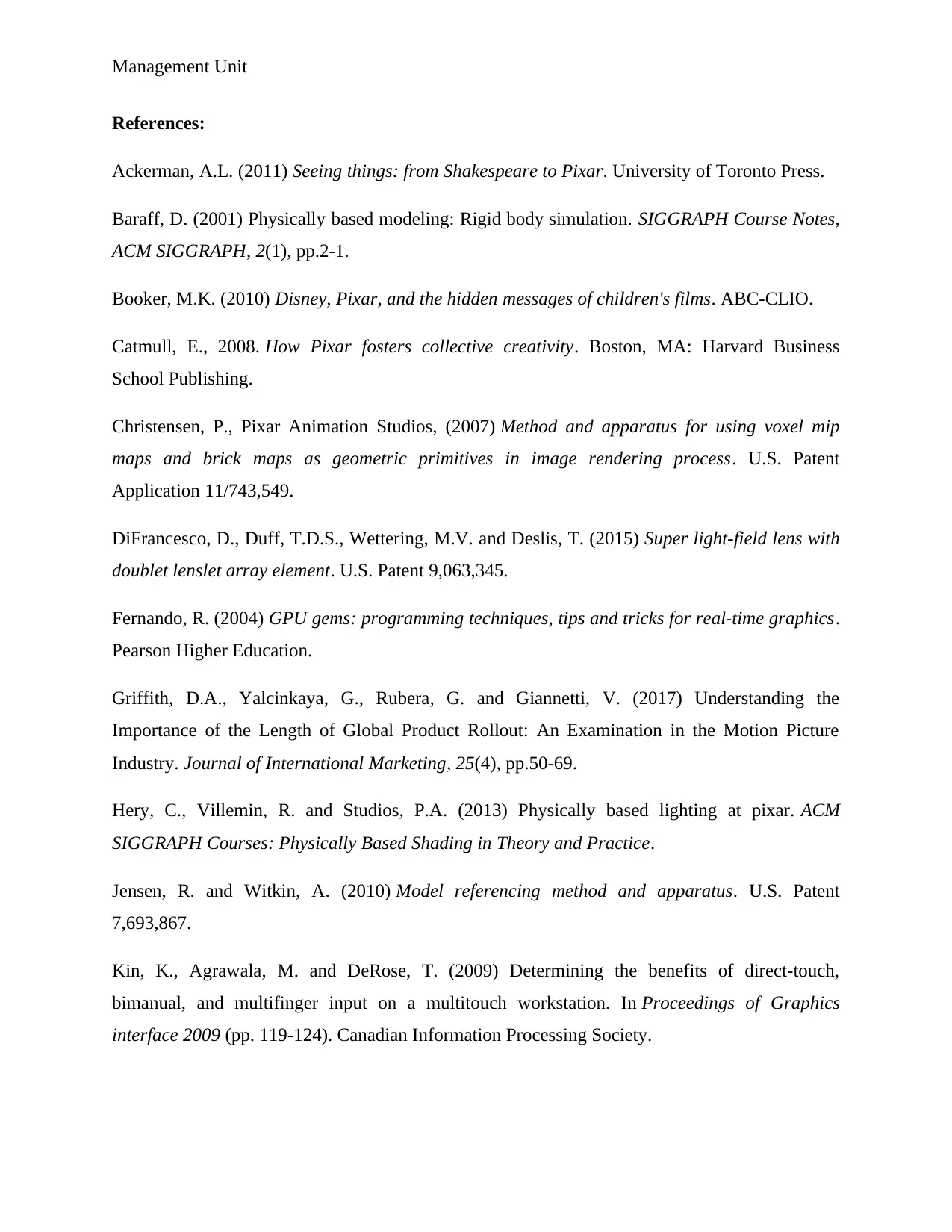
Management Unit
References:
Ackerman, A.L. (2011) Seeing things: from Shakespeare to Pixar. University of Toronto Press.
Baraff, D. (2001) Physically based modeling: Rigid body simulation. SIGGRAPH Course Notes,
ACM SIGGRAPH, 2(1), pp.2-1.
Booker, M.K. (2010) Disney, Pixar, and the hidden messages of children's films. ABC-CLIO.
Catmull, E., 2008. How Pixar fosters collective creativity. Boston, MA: Harvard Business
School Publishing.
Christensen, P., Pixar Animation Studios, (2007) Method and apparatus for using voxel mip
maps and brick maps as geometric primitives in image rendering process. U.S. Patent
Application 11/743,549.
DiFrancesco, D., Duff, T.D.S., Wettering, M.V. and Deslis, T. (2015) Super light-field lens with
doublet lenslet array element. U.S. Patent 9,063,345.
Fernando, R. (2004) GPU gems: programming techniques, tips and tricks for real-time graphics.
Pearson Higher Education.
Griffith, D.A., Yalcinkaya, G., Rubera, G. and Giannetti, V. (2017) Understanding the
Importance of the Length of Global Product Rollout: An Examination in the Motion Picture
Industry. Journal of International Marketing, 25(4), pp.50-69.
Hery, C., Villemin, R. and Studios, P.A. (2013) Physically based lighting at pixar. ACM
SIGGRAPH Courses: Physically Based Shading in Theory and Practice.
Jensen, R. and Witkin, A. (2010) Model referencing method and apparatus. U.S. Patent
7,693,867.
Kin, K., Agrawala, M. and DeRose, T. (2009) Determining the benefits of direct-touch,
bimanual, and multifinger input on a multitouch workstation. In Proceedings of Graphics
interface 2009 (pp. 119-124). Canadian Information Processing Society.
References:
Ackerman, A.L. (2011) Seeing things: from Shakespeare to Pixar. University of Toronto Press.
Baraff, D. (2001) Physically based modeling: Rigid body simulation. SIGGRAPH Course Notes,
ACM SIGGRAPH, 2(1), pp.2-1.
Booker, M.K. (2010) Disney, Pixar, and the hidden messages of children's films. ABC-CLIO.
Catmull, E., 2008. How Pixar fosters collective creativity. Boston, MA: Harvard Business
School Publishing.
Christensen, P., Pixar Animation Studios, (2007) Method and apparatus for using voxel mip
maps and brick maps as geometric primitives in image rendering process. U.S. Patent
Application 11/743,549.
DiFrancesco, D., Duff, T.D.S., Wettering, M.V. and Deslis, T. (2015) Super light-field lens with
doublet lenslet array element. U.S. Patent 9,063,345.
Fernando, R. (2004) GPU gems: programming techniques, tips and tricks for real-time graphics.
Pearson Higher Education.
Griffith, D.A., Yalcinkaya, G., Rubera, G. and Giannetti, V. (2017) Understanding the
Importance of the Length of Global Product Rollout: An Examination in the Motion Picture
Industry. Journal of International Marketing, 25(4), pp.50-69.
Hery, C., Villemin, R. and Studios, P.A. (2013) Physically based lighting at pixar. ACM
SIGGRAPH Courses: Physically Based Shading in Theory and Practice.
Jensen, R. and Witkin, A. (2010) Model referencing method and apparatus. U.S. Patent
7,693,867.
Kin, K., Agrawala, M. and DeRose, T. (2009) Determining the benefits of direct-touch,
bimanual, and multifinger input on a multitouch workstation. In Proceedings of Graphics
interface 2009 (pp. 119-124). Canadian Information Processing Society.
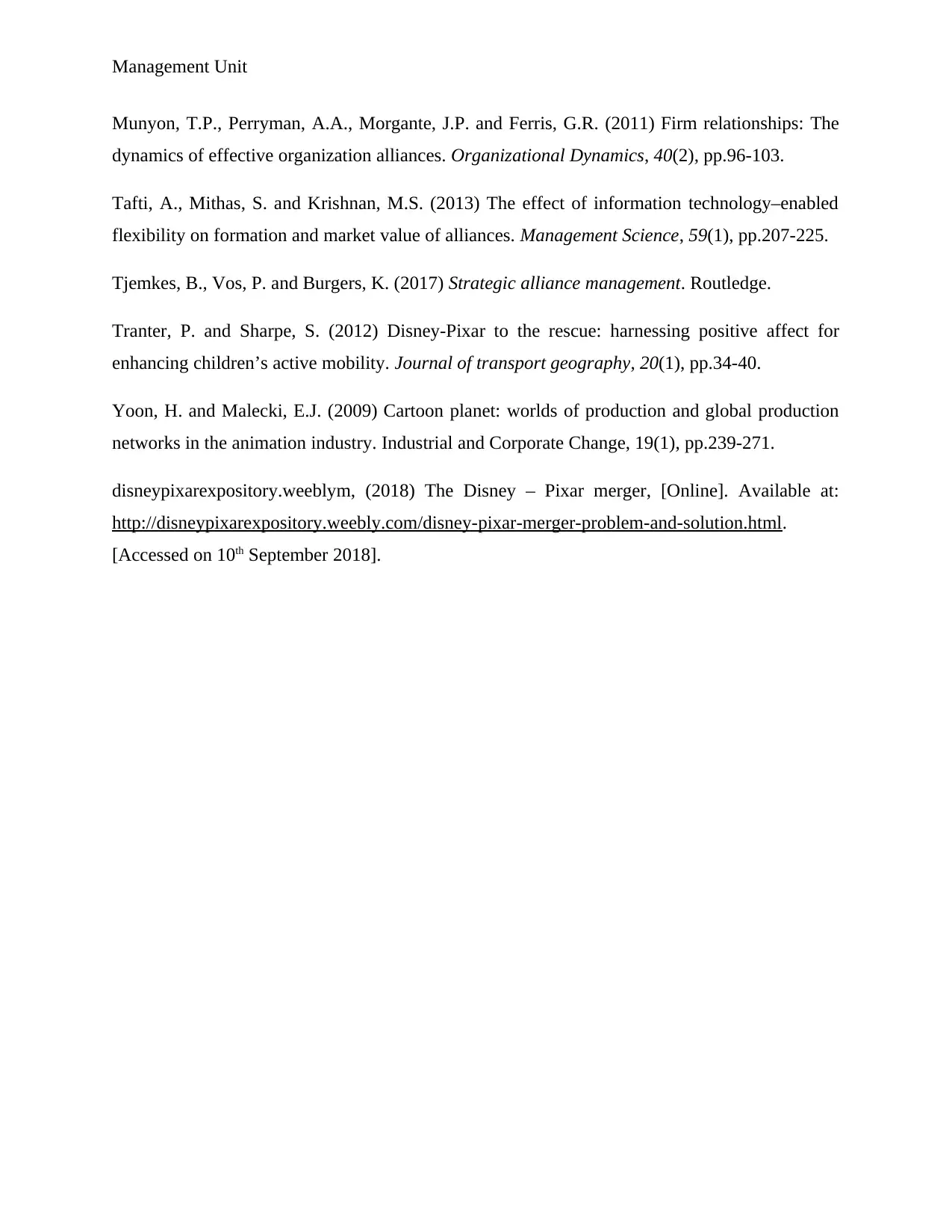
Management Unit
Munyon, T.P., Perryman, A.A., Morgante, J.P. and Ferris, G.R. (2011) Firm relationships: The
dynamics of effective organization alliances. Organizational Dynamics, 40(2), pp.96-103.
Tafti, A., Mithas, S. and Krishnan, M.S. (2013) The effect of information technology–enabled
flexibility on formation and market value of alliances. Management Science, 59(1), pp.207-225.
Tjemkes, B., Vos, P. and Burgers, K. (2017) Strategic alliance management. Routledge.
Tranter, P. and Sharpe, S. (2012) Disney-Pixar to the rescue: harnessing positive affect for
enhancing children’s active mobility. Journal of transport geography, 20(1), pp.34-40.
Yoon, H. and Malecki, E.J. (2009) Cartoon planet: worlds of production and global production
networks in the animation industry. Industrial and Corporate Change, 19(1), pp.239-271.
disneypixarexpository.weeblym, (2018) The Disney – Pixar merger, [Online]. Available at:
http://disneypixarexpository.weebly.com/disney-pixar-merger-problem-and-solution.html.
[Accessed on 10th September 2018].
Munyon, T.P., Perryman, A.A., Morgante, J.P. and Ferris, G.R. (2011) Firm relationships: The
dynamics of effective organization alliances. Organizational Dynamics, 40(2), pp.96-103.
Tafti, A., Mithas, S. and Krishnan, M.S. (2013) The effect of information technology–enabled
flexibility on formation and market value of alliances. Management Science, 59(1), pp.207-225.
Tjemkes, B., Vos, P. and Burgers, K. (2017) Strategic alliance management. Routledge.
Tranter, P. and Sharpe, S. (2012) Disney-Pixar to the rescue: harnessing positive affect for
enhancing children’s active mobility. Journal of transport geography, 20(1), pp.34-40.
Yoon, H. and Malecki, E.J. (2009) Cartoon planet: worlds of production and global production
networks in the animation industry. Industrial and Corporate Change, 19(1), pp.239-271.
disneypixarexpository.weeblym, (2018) The Disney – Pixar merger, [Online]. Available at:
http://disneypixarexpository.weebly.com/disney-pixar-merger-problem-and-solution.html.
[Accessed on 10th September 2018].
⊘ This is a preview!⊘
Do you want full access?
Subscribe today to unlock all pages.

Trusted by 1+ million students worldwide
1 out of 9
Your All-in-One AI-Powered Toolkit for Academic Success.
+13062052269
info@desklib.com
Available 24*7 on WhatsApp / Email
![[object Object]](/_next/static/media/star-bottom.7253800d.svg)
Unlock your academic potential
Copyright © 2020–2025 A2Z Services. All Rights Reserved. Developed and managed by ZUCOL.

